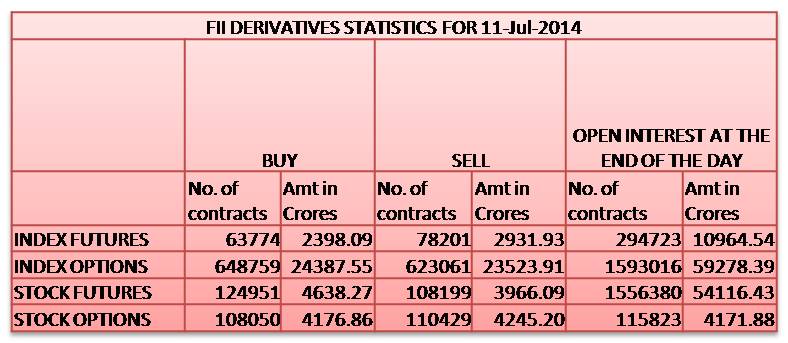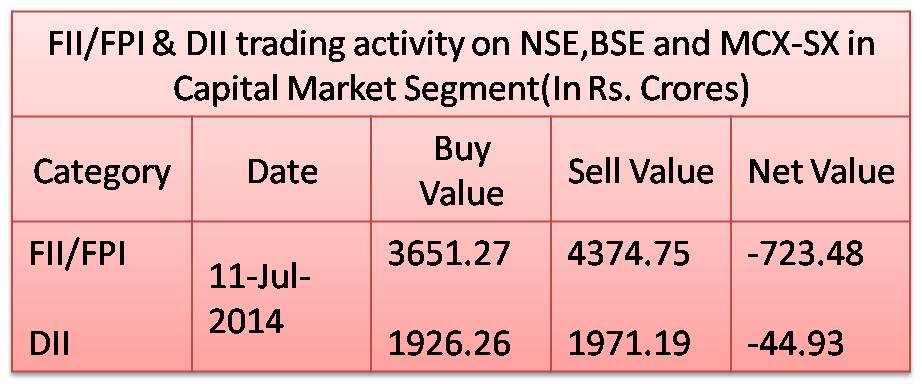Monsoon to pick up in central, northwestern India by Jul 15
Monsoon in central and northwestern India, which is currently reeling under severe heat, is likely to pick up by July 15, said the MeT department.
IMD Director BP Yadav said that pressure in Bay of Bengal has affected monsoon and that there will be humidity till July 14.
He also said that the present weather is due to absence of clouds. Weak rainfall in the country since June when the monsoon season starts, crucial to the agricultural earnings, has raised concerns of a first drought in five years.
However, Finance Minister Arun Jaitley has assured that the government was prepared to tackle a drought situation. In 2009 the worst drought in nearly four decades forced India, the world’s top sugar consumer, to buy large quantities of the sweetener from top producer Brazil, driving benchmark New York futures to a 30-year high.
Germany become world champions again

Germany’s players pose for pictures as they celebrate with their World Cup trophy after winning their 2014 World Cup final against Argentina at the Maracana stadium in Rio de Janeiro July 13, 2014.
Budget 2014 has brought clarity in tax policies: FinMin
Government today said the Budget 2014-15 has brought about clarity in tax policies and it will walk the difficult path to bring growth impulses back into the economy amidst fiscal constraints.
“Both on direct and indirect tax side, the main focus of the government was to revive growth, to revive manufacturing sector, to take steps that will result in creation of jobs, go in for tax rationalisation, reduce tax litigations and ambiguity in policies,” Revenue Secretary Shaktikanta Das said.
At the post-budget interaction with industry chamber Ficci, Das said the Budget has sought to bring in greater clarity in taxation policy. In his maiden Budget presented in Parliament on July 10, Finance Minister Arun Jaitley has tried to provide relief to the middle class by increasing tax exemption limit by Rs 50,000 to Rs 2.50 lakh.
It also hiked deduction limit for investments in financial instruments under 80C by Rs 50,000 to Rs 1.50 lakh. The Budget contains several proposals to boost the manufacturing sector apart from assurance that government will not “ordinarily” bring about any change retrospectively which creates a fresh “liability” or tax demand.
Finance Secretary Arvind Mayaram, who along with other secretaries of the Finance Ministry was interacting with industry leaders, said government was open to discussing ideas with them and addressing their concerns. “My own perspective is that this is a growth oriented Budget. It will bring the growth impulses back into the economy…we will have to move a very difficult path ahead, but there is a determination that the government would walk that path,” Mayaram said.
India’s economic growth slumped to sub 5 per cent in the past two fiscals leading slowdown in revenue generation and high fiscal deficit. The government has pledged to bring the fiscal deficit down to 4.1 per cent of GDP in the current fiscal from 4.5 per cent in the last year.
M6.8 quake hits Japan, triggering small tsunami
 A strong earthquake hit off Fukushima Prefecture early Saturday, triggering a small tsunami and injured at least one person.
A strong earthquake hit off Fukushima Prefecture early Saturday, triggering a small tsunami and injured at least one person.
The Japan Meteorological Agency said the 6.8-magnitude quake struck 10 kilometers below the sea surface off the coast of Fukushima at 4:22 a.m. The quake shook buildings in Tokyo, about 250 kilometers southwest of the epicenter.
A 20-centimeter tsunami reached the coast of Ishinomaki Ayukawa and Ofunato, about 50 minutes after the quake. Smaller waves were observed at several other locations along the coast. Changes to the shoreline were not visible on television footage of NHK public broadcaster.
In Fukushima, a 68-year-old woman fell down the stairs and broke her leg, according to the prefectural police. No damage was reported.
Eight towns devastated by the tsunami three years ago, including Rikuzentakata, Higashi Matsushima and Otsuchi, issued evacuation advisories to thousands of households along the northern coast, along with schools and community centers.
All tsunami and evacuation advisories were lifted about two hours after the quake.
The stricken Fukushima Daiichi and two other nuclear power plants, along with other nuclear facilities along the coast, found no abnormalities, and their reactors and fuel storage pools are being cooled safely, according to the Nuclear Regulation Authority.
Tokyo Electric Power Co, which operates the Fukushima Daiichi plant, has instructed plant workers on night duty along the coast to retreat to higher grounds.
SBI, PNB likely to tap capital market this year: Finmin
Public sector SBI and PNB could be among the first banks to tap capital market this financial year to raise funds to meet global risk norms Basel III, a top finance ministry official said here today.
Financial Services Secretary G S Sandhu also said no final decision has been taken yet. “Which banks will go first, that we have to work out. We have asked all banks to submit their capital requirement plans.
They have given their proposal and we are giving final touch to them. The schedule will be worked out soon,” he added. The decision would be based on various consideration including value of shares and possibility of going up further, he said. Yesterday, Finance Minister Arun Jaitley in the Budget speech said that “to be in line with Basel-III norms there is a requirement to infuse Rs 2,40,000 crore as equity by 2018 in our banks. To meet this huge capital requirement we need to raise additional resources to fulfill this obligation.”
While preserving the public ownership, the capital of these banks will be raised by increasing the shareholding of the people in a phased manner through the sale of shares largely through retail to common citizens of this country, he had said. “Thus, while the government will continue to have majority shareholding, the citizens of India will also get direct shareholding in these banks, which currently they hold indirectly,” he had said.
Government shareholding in various banks varies between 56.26 percent to 88.63 percent. “So, we will have to devise a strategy where we figure how much dilution will take place in these banks over a five- year time-frame, because we are not going to do it in just one go which is not possible also.
This will happen over a timeframe of five years,” he said. Price to book value of the shares of most of the banks are close to one, he said, adding, “We expect them to go a little higher.”
Positives & Negatives of this Week
1. Despite a nasty opening on Wednesday, the S&P 500 is less than 1% away from its all-time high.
2. Japanese consumer confidence rose to 41.1 from 39.3, the highest of the year.
3. Average gas price is down to $3.64, the lowest levels since April
4. The Fed announced they will end their taper in October with a $15B reduction in stimulus.
5. Initial jobless claims fell to 304k, down from 315k last week and below expectations.
6. AAII bearish sentiment had the biggest one week increase since April, working off some froth is healthy.
7. Job openings in May increased to 4.63M from 4.46, the most since June ’07.
8. MBA home applications rose 3.7% w/o/w
Negatives:
1. Troubles with Banco Espirito Santo (Portgual) spooked the market on Wednesday, the S&P had its largest gap down since early March, the Russell 2000 had the largest gap down since ’12.
2. German exports drop 1.1% in May m/o/m, more than the estimate of down .4% and April is revised lower
3. Baltic Dry Index-This week down by 8.54%
4. Japanese machinery orders cratered 19.5% m/o/m
5. NFIB small business optimism index fell to 95 from 96.6
6. Student loan debt outstanding in rose to yet another record high in May.
7.BSE SENSEX is down by 937.71 points and Nifty is Down by 292 points
May IIP at 4.7%, highest level since Oct 2012
 The Index of Industrial Production (IIP) for the month of May came in at 4.7 percent versus 3.4 percent month-on-month.
The Index of Industrial Production (IIP) for the month of May came in at 4.7 percent versus 3.4 percent month-on-month.
The factory output in May is at a 19-month high – highest since October 2012. Electricity sector growth came in at 6.3 percent against 11.9 percent MoM.
Manufacturing sector growth too jumped to 4.8 percent versus 2.6 percent in April. Mining sector growth too improved at 2.7 percent against 1.2 percent MoM.
The jump in May IIP data is slightly surprising considering India’s core industry growth for May slowed to 2.3 percent versus 4.2 percent month-on-month (MoM) and 5.9 percent year-on-year (YoY) and core sector is 38 percent in the Index of Industrial Production.
Sector Break-up
Consumer non-durables Growth At 3.9 percent versus -3.3 percent (MoM)
Consumer durables growth at 3.2 percent Vs -7.6 percent (MoM)
Intermediate goods growth at 2.7 percent Vs 4.4 percent (MoM)
Consumer goods growth at 3.7 percent Vs -5.1 percent (MoM)
Capital goods growth at 4.5 percent Vs 15.7 percent (MoM)
Basic goods growth at 6.3 percent Vs 6.8 percent (MoM)
May IIP Expected at 3.76%
The Index of Industrial Production (IIP) for the month of May is expected to be 3.76 percent versus 3.4 percent.
However, the range could be anywhere between 3 to 4.3 percent. There are some outlier estimates for IIP to be anywhere between 0.8 to 6 percent, which shows that a lot of volatility is expected from the figure. Some of the cues that one could look at are the base effect which may be favourable for the IIP figure.
For example in May 2013 the IIP contracted 2.5 percent with manufacturing contracting 3.2 percent.
We also have a data that indicates manufacturing could continue to be in the positive terrain. For example exports in the month of May 2014 that came out of the trade deficit data was quite positive.
It was in double digits. Besides that there was a Year-on-Year rise in the passenger vehicles’ data was up 4 percent in the month of May. One could also look at the sustained two-wheeler output.






